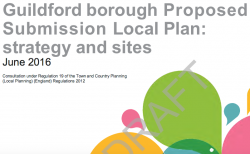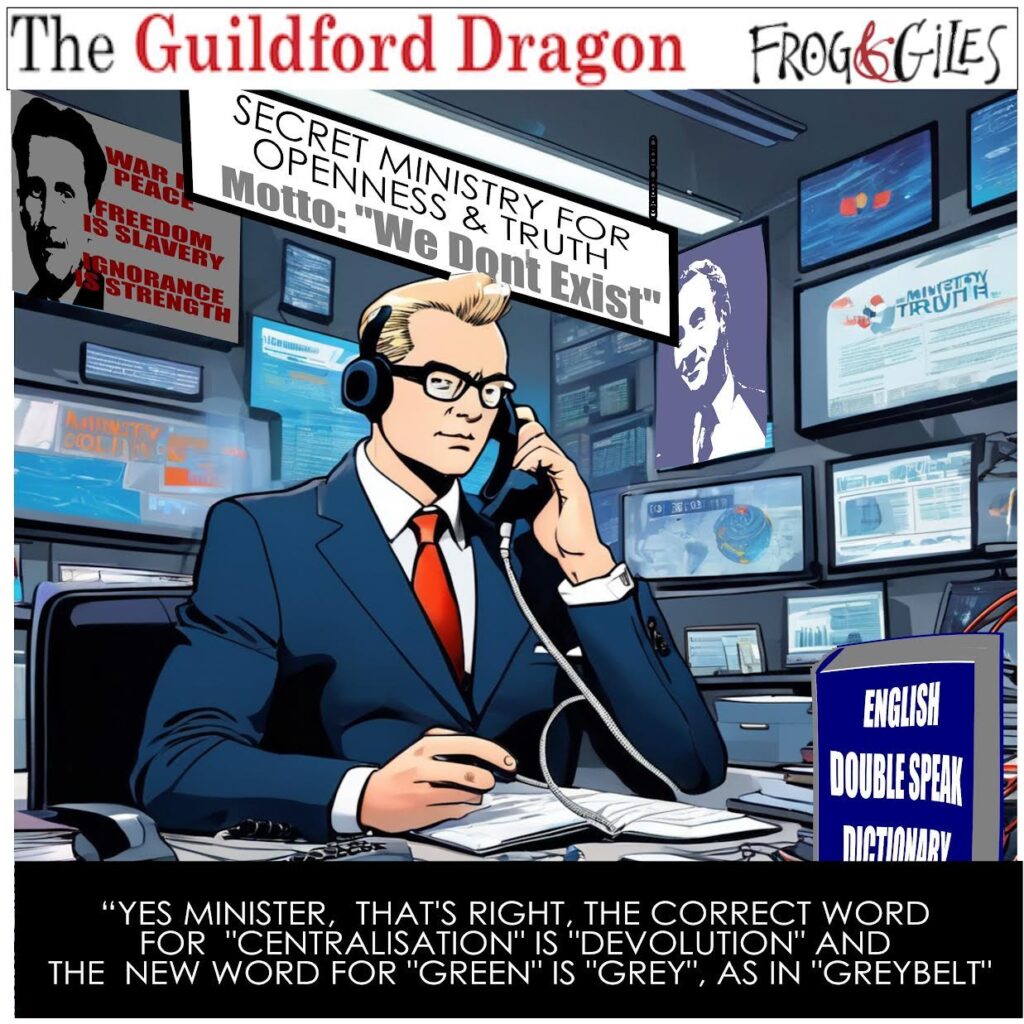 Abraham Lincoln
If given the truth, the people can be depended upon to meet any national crisis...
Abraham Lincoln
If given the truth, the people can be depended upon to meet any national crisis...
 Guildford news...
for Guildford people, brought to you by Guildford reporters - Guildford's own news service
Guildford news...
for Guildford people, brought to you by Guildford reporters - Guildford's own news service
Letter: Are We Looking At the Housing Problem From The Wrong End?
Published on: 16 Jul, 2016
Updated on: 16 Jul, 2016
I am born and bred a Guildfordian, unlike, I suspect, many of those proposing the acceptance of the proposed housing explosion in our area under the draft Local Plan.
Many come here because it is a lovely town, still surrounded by green belt countryside, yet having a diversity of employment suitable to most, but still outside the sprawling London suburbs they have left.
Surely to retain that attraction we have to maintain it, not destroy it!
We are already seeing the awful effects around us of home extensions and an anything goes policy of planning applications, destroying the character of many areas.
Perhaps we are looking at the housing problem from the wrong end? Maybe we should be looking at local authority built housing, to satisfy the huge demand at that end of the market – be it shared housing or rented? Control and asset ownership would then be in the hands of the people, through the council.
My experience is that housing markets are dictated by first time buyers. But building more social housing would be a way of controlling that process.
Building thousands of houses at the £600,000 to £1 million pound end of the market, around Guildford, is not the way forward. That would only satisfy the pockets of the developers, the ego of council development officers and those who could afford to buy anywhere.
Responses to Letter: Are We Looking At the Housing Problem From The Wrong End?
Leave a Comment Cancel reply
Please see our comments policy. All comments are moderated and may take time to appear. Full names, or at least initial and surname, must be given.Recent Articles
- Highways Bulletin: Roadside Rangers Making a Visible Difference Across Surrey
- Letter: The Enduring Role of Parish and Town Councils
- Mr Carpenter’s Byfleet Seedling and Other Varieties of Apples
- Guildford MP Visits Local Satellite Firm During 40th Anniversary Year
- Letter: Only a Town Council Will Give Us to the Option to Choose on Some Local Services
- Comment: Parish Councils – Who Cares?
- Update: North Street Re-opened
- Letter: Parish and Town Councils Will Become More Essential Than Ever
- Plans for Several Railway Repair Projects Over August Bank Holiday
- Letter: We Should Thank Parish Councillors



Recent Comments
- Jim Allen on Letter: The Enduring Role of Parish and Town Councils
- Olly Azad on Comment: Parish Councils – Who Cares?
- Jan Messinger on Letter: The Enduring Role of Parish and Town Councils
- George Potter on Letter: Only a Town Council Will Give Us to the Option to Choose on Some Local Services
- Fiona Yeomans on Dragon Review: A Comedy of Errors and A Company of Rascals – Yvonne Arnaud Theatre
- D Kaur on ‘We Need To Get This Right,’ Says Coroner at Sara Sharif Pre-inquest Review
Search in Site
Media Gallery
Dragon Interview: Local Artist Leaves Her Mark At One of England’s Most Historic Buildings
January 21, 2023 / No Comment / Read MoreDragon Interview: Lib Dem Planning Chair: ‘Current Policy Doesn’t Work for Local People’
January 19, 2023 / No Comment / Read MoreA3 Tunnel in Guildford ‘Necessary’ for New Homes, Says Guildford’s MP
January 10, 2023 / No Comment / Read More‘Madness’ for London Road Scheme to Go Ahead Against ‘Huge Opposition’, Says SCC Leader
January 6, 2023 / No Comment / Read MoreCouncillor’s Son Starts Campaign for More Consultation on North Street Plan
December 30, 2022 / No Comment / Read MoreCounty Council Climbs Down Over London Road Works – Further ‘Engagement’ Period Announced
December 14, 2022 / No Comment / Read MoreDragon Interview: GBC Reaction to the Government’s Expected Decision to Relax Housing Targets
December 7, 2022 / No Comment / Read MoreHow Can Our Town Centre Businesses Recover? Watch the Shop Front Debate
May 18, 2020 / No Comment / Read More












John Perkins
July 16, 2016 at 8:18 pm
I quite agree. There are plenty of ‘executive’ boxes in the area already, what is needed is social housing. GBC played a big part in bringing about the problem by not replacing council houses which it sold. Now it seems to want to build homes only for the wealthy. Any place inhabited by just the rich is sterile indeed.
Jules Cranwell
July 16, 2016 at 10:16 pm
If only the leaders at GBC were this were this perceptive.
Let’s have P Gatford on the council.
Valerie Thompson
July 17, 2016 at 8:32 am
Sadly GBC will not be able to build low-cost housing as they have spent millions on vanity projects, public sculptures, a re-vamp of their own offices, buying office buildings at vast prices, commissioning documents to be produced (e.g. the SHMA), when they could have done research themselves, etc.
Of course, it was the Conservatives who promoted the idea of selling off council houses and not using the income to build new ones.
In an ideal world GBC would build new, small homes and low-rise flats, mainly for sale, and with the profit they could build some more.
Jim Allen
July 17, 2016 at 9:22 am
Well written. I think the problem started in the late 70s when mortgages were written based on a persons ‘self stated’ income. If they had been based on P60s and P45s house prices would never have risen so far and so fast. There’s nothing super clever about owing money. Clever people don’t owe a penny.
Now with the sale of our ‘worker’ housing to those just a little richer than those who actually need those homes – an inverted philosophy if ever there was one – we should be replacing them, not building ‘Country Life’ low cost housing.
A problem I fear that the 15 homes being built (foundations being dug as I write) at the end of Slyfield Green will do little in numerical terms to to solve the over-arching problem that we are not all bankers from The City. Some of us are tradesmen and labourers, living in the real world, who provide services to the rich communities of Guildford.
Ramsey Nagaty
July 18, 2016 at 11:02 am
This hits the nail right on the head.
Bernard Parke
July 18, 2016 at 12:15 pm
Perhaps the problem can be traced back to the Repeal of The Trucks Act.
Up to that time wages had to be paid in cash so security vans carried large sums of money around the country. This led to an increase of criminal activity in the form of robberies and hold ups.
With the repeal of the Act wage earners were encouraged to open bank accounts. This was favoured by the joint stock banks with their fledgling computer systems and increased capacity to accommodate these new customers with what the they called “cloth cap banking”.
However, the situation was not helped when the banks suddenly closed on Saturday mornings; the only day when this new section of bank customers could visit their new banks.
Money was then withdrawn from the banks and accounts were opening with the building societies.
The building societies became the new bankers and were awash with money and the banks were in effect then reduced to just pay masters.
But the building societies, then, could only advance money for house purchases. So this new flood of funds lead to the start of over lending which was the root cause of the rapid increase in the cost of the family homes.
Up to then the joint stock banks were only really interested in medium term lending, up to five year periods.
Lending for house purchase was regarded as bad lending. It was difficult to value the true value of a house until it was actually sold, and realising the security, in the case of default, would perhaps mean turning families on to the street. Such bad publicity would, of course, not be welcomed.